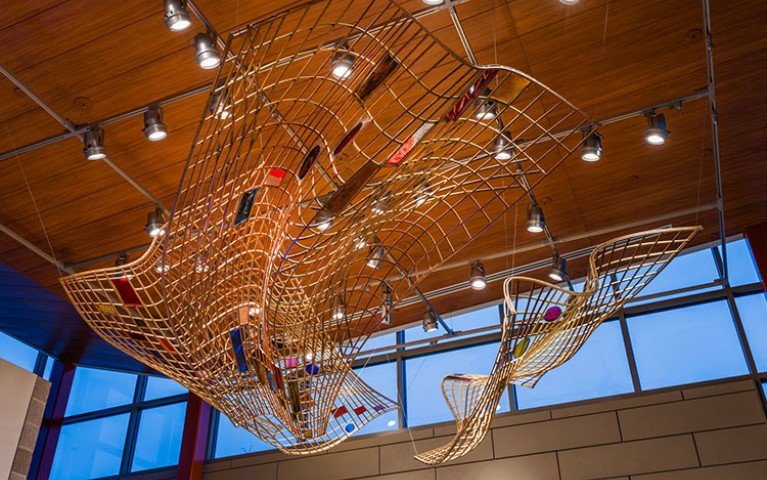Weaving Us Whole

This story originally appeared in our spring edition of News from HOME.
Project HOME’s vision has never simply been about housing. It has been about healing. All of our work—housing, advocacy for those on the margins, the building of community, the restoration of neighborhoods, and our work on education, recovery, and the arts—has been toward a vision of wholeness in an unwell society.
We believe that solving homelessness hinges on healing, and healing individuals involves much more than shelter. It is providing a place—supporting each of us in a community which reminds us of the gifts which are ours alone to offer. We’ve learned that bringing people in from the streets also demands that we restore the fabric of fragile, battered neighborhoods and prevent homelessness at the outset.
Perhaps this is why artist Meg Saligman, when commissioned to envision art for our new Stephen Klein Wellness Center (SKWC), asked neighbors and friends to bring in a fabric or a talisman which was important to them. Resident Doug Sanders brought his painting rag. Neighbor and community leader Lenora Jackson-Evans brought a blanket of family photos. Staff member Lucy Kibe brought a woven basket from her native Kenya, and community health outreach worker Loretta Dredden brought a cloth bag holding the shining coins of recovery. Meg fingered them, listened to the stories. “I am always surprised at how people share such intimate, meaningful memories,” she reflects. “It was my intent to bring these memories from the homes, the living rooms, bedrooms and closets that are scattered throughout this community to live within this new center—influencing, inspiring, and providing comfort.”
When you walk into the center you aregreeted by the fruit of their collaborativework, a sculpture called “Woven Sanctuary.”Inspired and designed fromthesecommunity voices, it interweaves water, glass, and light. The walls are covered with images drawn from these cloths, and the doorway says simply: “Dedicated to those who come in need of healing.”
This is especially appropriate because the rise of homelessness in this country, so dramatic in the early 1980s, was sparked in part by medical realities and the inadequacies of the healthcare system. (There were dramatic cuts in housing supports at the same time.) Large mental-health facilities (here, the Philadelphia State Hospital at Byberry) were closed with few options. The rise of cheap street drugs fueled addictions (also a medical issue) which added to numbers on our streets. The vision of the SKWC—“To heal mind, body, spirit, and community”—states cleanly and simply what Project HOME has been about from the outset.
That healing is both personal and social. At the official opening, Monica Medina McCurdy, Project HOME’s Vice President of Health Services, recounted the history of the corner where the center sits: “Fifty years ago, an altercation here caused this street to erupt in several days of riots—an ‘ignition event’ during the civil-rights era that resulted in eight blocks of Cecil B. Moore Avenue (then Columbia Avenue), all the way to Broad Street, being destroyed or set on fire. Overnight, this street went from a thriving commercial district with every necessity at hand to a community which never fully recovered. With the SKWC and other economic activity happening here, we hope to be part of new life.”
Neighborhood resident and pillar of the community Helen Brown comments: “The words ‘woven sanctuary’ are themselves a statement; a sacred place that you can go to. We have a very close-knit neighborhood now.” Long ago, we discovered this truth: we all need healing, and we begin to find it when we draw all people into that vision. On opening day, Monica Medina McCurdy expressed her yearning for the Center to be a place where each person “feels safe, listened to, and respected.”
Project HOME has always aspired to be that place. We will only find this healing together, listening to each other, weaving our lives and paths back together.